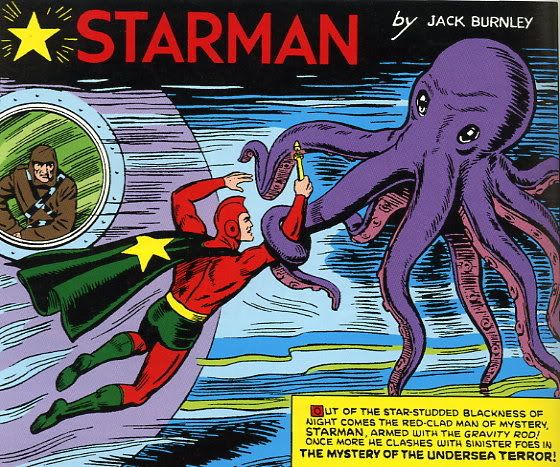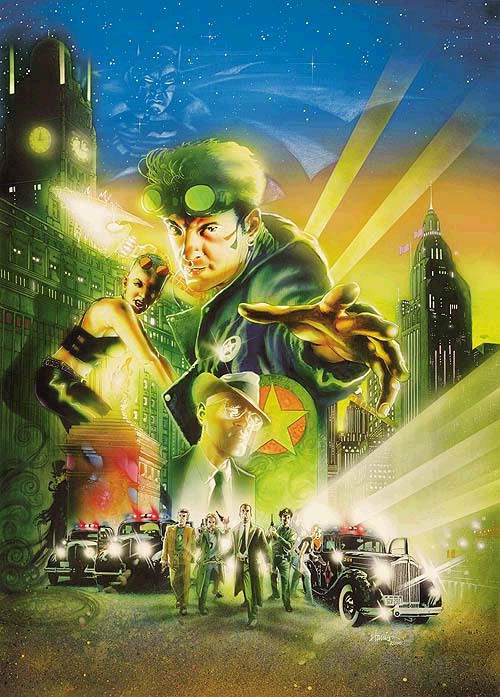Sunday, April 19, 2009
Saturday, April 11, 2009
Police Cops
I was watching Lost the other night. There was a cop show following, a not-entirely-unenjoyable cop show at that, but it got me and my friend thinking: just how many cop shows are on the air? After perusing imdb's TV listings, I've come up with the following list:
Forensic Science Shows:
CSI: Original Recipe
CSI: Miami
CSI: New York
NCIS
Cop Shows:
Castle
Life
The Unusuals
Flashpoint
Southland
Cold Case
Shows about the FBI:
Fringe
The Mentalist
Bones
Criminal Minds
Numb3rs
Without a Trace
Law and Order variations:
L&O: Original Recipe
L&O: SVU
L&O: CI
For convenience's sake I'm sticking to broadcast networks (sorry, The Closer and Sue Thomas, F.B.Eye). Nineteen shows, spread out over the course of a week. That's almost three a day, for those of you playing Basic Arithmetic, the Home Game. So I had a thought. A once-in-a-lifetime Primetime TV event: Every cop show, every night, every network. Different teams, different approaches, but they all must solve the exact same murder.
Not a crossover. Rather, here's how it works: With only minor geographic changes, the story of, let's say, a prominent investment banker who was beaten to death with a name-brand shoe outside The West 43rd Savings and Loan. His money is in his pocket, this was no robbery. Now, each show's crack detective team, from CSI Miami's Horatio Caine and his sunglasses and crappy one-liners to Fringe's Walter Bishop and his mind control swimming pool, must each interview the suspects, uncover the evidence, make with the snarky, and solve the murder. Every cop show, every night.
You could have big-name guest stars, real method guys who'd have no problem putting the exact same spin on the exact same murder case, night after night, for what amounts to the better part of three weeks. We'd become familiar with their ins and outs. CSI's crew obsesses over tiny shards of glass while Bones Feds deal with the impact of Nike tread on someone's skull and The Mentalist himself gets all wiggy with potential suspects.
Each suspect is asked the same questions, slightly differently. The jokes are new, the banter and the b-plots of course there to keep us interested, since by Monday night we all know the score. But it's fun to watch them, dancing over and around the same evidence, coming to the same conclusions at just the last second, sparing the innocent man and damning the guilty. Upholding justice. Saving the day, every day.
It'd be awesome.
Forensic Science Shows:
CSI: Original Recipe
CSI: Miami
CSI: New York
NCIS
Cop Shows:
Castle
Life
The Unusuals
Flashpoint
Southland
Cold Case
Shows about the FBI:
Fringe
The Mentalist
Bones
Criminal Minds
Numb3rs
Without a Trace
Law and Order variations:
L&O: Original Recipe
L&O: SVU
L&O: CI
For convenience's sake I'm sticking to broadcast networks (sorry, The Closer and Sue Thomas, F.B.Eye). Nineteen shows, spread out over the course of a week. That's almost three a day, for those of you playing Basic Arithmetic, the Home Game. So I had a thought. A once-in-a-lifetime Primetime TV event: Every cop show, every night, every network. Different teams, different approaches, but they all must solve the exact same murder.
Not a crossover. Rather, here's how it works: With only minor geographic changes, the story of, let's say, a prominent investment banker who was beaten to death with a name-brand shoe outside The West 43rd Savings and Loan. His money is in his pocket, this was no robbery. Now, each show's crack detective team, from CSI Miami's Horatio Caine and his sunglasses and crappy one-liners to Fringe's Walter Bishop and his mind control swimming pool, must each interview the suspects, uncover the evidence, make with the snarky, and solve the murder. Every cop show, every night.
You could have big-name guest stars, real method guys who'd have no problem putting the exact same spin on the exact same murder case, night after night, for what amounts to the better part of three weeks. We'd become familiar with their ins and outs. CSI's crew obsesses over tiny shards of glass while Bones Feds deal with the impact of Nike tread on someone's skull and The Mentalist himself gets all wiggy with potential suspects.
Each suspect is asked the same questions, slightly differently. The jokes are new, the banter and the b-plots of course there to keep us interested, since by Monday night we all know the score. But it's fun to watch them, dancing over and around the same evidence, coming to the same conclusions at just the last second, sparing the innocent man and damning the guilty. Upholding justice. Saving the day, every day.
It'd be awesome.
Thursday, April 9, 2009
Wednesday, April 8, 2009
Sunday, April 5, 2009
Waiting in the Sky
Gather 'round, children, to hear the tale from the halcyon days of the mid-nineties, a time when money flowed like wine, wine flowed like even more wine, and the national debt was something Chris Rock made fun of in ads for KFC. Gather 'round to hear of the Greatest Superhero Movie you'll never see. Gather 'round to hear of Starman.
No. Not the movie with The Dude. Or the short-lived TV show with the guy from 'Airplane.' No, to tell the story of the Starman, we'll have to take a trip back to 1940, with DC's 'Adventure Comics.'
By 1940, superheroes were a solid win for the comics industry, pushing the western, aviation and detective stories farther back in to the support columns. Along with debuting their first superhero group, the Justice Society, DC unveiled a few new characters, among them Ted Knight, the Starman.
Ted's thing was that he was a millionaire playboy. Heard that before? Well, this time he's a millionaire playboy astronomer, one who designed a mechanical rod powered by cosmic energy. In true comic book form, Ted takes his invention, which easily could have revolutionized the energy industry, and dons some tights and beats the crap out of people with it. Starman was born.

And he was kind of generic. He had a cool gadget, but so did the Green Lantern, he was a millionaire playboy and a scientist, but comics were full of millionaire playboys who didn't have to pull double-duty on the telescope circuit. Poor Ted's adventures didn't quite make it out of the Fifties.
Ah, but they had the name, and a string of reboots and recharacterizations followed. Oh, to be a second-stringer in the DCU.
Which brings us to 1994. As part of a plan to revitalize some of its underused names, DC decided to relaunch Starman. Of these reboots, it would be the only one that would take.

That guy in the goggles, that's our boy. Jack. The son of the original Starman. And here's where the plot of the Unmade Movie comes in to play. Jack doesn't start out wanting to be Starman. His brother's doing fine with the job and he and Jack don't get along. That's right up until Davey is snipered from a rooftop and the city erupts in flames. The Mist, Ted's old nemesis from the Forties is back, and he's got his own kids in tow, the vicious, murdering Kyle and the shrinking violet Nash.
Thrust in to the whole adventuring thing, and eager to avenge the death of his brother, Jack comes face to face first with Nash, who lets him go and later with the old man himself and Kyle, who killed his brother. Jack kills Kyle and the police nab both The Mist and Nash.
Boom. There's your first movie. Only Nash, she goes a bit crazy. She busts out of jail and proceeds to terrorize Jack and the city. And this is where it gets good, really. These two characters, two superheroes, are trapped in this cycle of violence started by their parents. In his seven years running the title, James Robinson deftly reinvented what it means to be a costumed hero and the pervasive nature of violence. Also, the man clearly loved comic books.

There was going to be a Starman TV show on the WB back when Smallville was first starting out and was a big hit, but the other superhero show on WB, Birds of Prey, tanked and the Starman idea was left to one side. Too bad. He's still out there, Hollywood. Waiting in the sky.
No. Not the movie with The Dude. Or the short-lived TV show with the guy from 'Airplane.' No, to tell the story of the Starman, we'll have to take a trip back to 1940, with DC's 'Adventure Comics.'
By 1940, superheroes were a solid win for the comics industry, pushing the western, aviation and detective stories farther back in to the support columns. Along with debuting their first superhero group, the Justice Society, DC unveiled a few new characters, among them Ted Knight, the Starman.
Ted's thing was that he was a millionaire playboy. Heard that before? Well, this time he's a millionaire playboy astronomer, one who designed a mechanical rod powered by cosmic energy. In true comic book form, Ted takes his invention, which easily could have revolutionized the energy industry, and dons some tights and beats the crap out of people with it. Starman was born.

And he was kind of generic. He had a cool gadget, but so did the Green Lantern, he was a millionaire playboy and a scientist, but comics were full of millionaire playboys who didn't have to pull double-duty on the telescope circuit. Poor Ted's adventures didn't quite make it out of the Fifties.
Ah, but they had the name, and a string of reboots and recharacterizations followed. Oh, to be a second-stringer in the DCU.
Which brings us to 1994. As part of a plan to revitalize some of its underused names, DC decided to relaunch Starman. Of these reboots, it would be the only one that would take.

That guy in the goggles, that's our boy. Jack. The son of the original Starman. And here's where the plot of the Unmade Movie comes in to play. Jack doesn't start out wanting to be Starman. His brother's doing fine with the job and he and Jack don't get along. That's right up until Davey is snipered from a rooftop and the city erupts in flames. The Mist, Ted's old nemesis from the Forties is back, and he's got his own kids in tow, the vicious, murdering Kyle and the shrinking violet Nash.
Thrust in to the whole adventuring thing, and eager to avenge the death of his brother, Jack comes face to face first with Nash, who lets him go and later with the old man himself and Kyle, who killed his brother. Jack kills Kyle and the police nab both The Mist and Nash.
Boom. There's your first movie. Only Nash, she goes a bit crazy. She busts out of jail and proceeds to terrorize Jack and the city. And this is where it gets good, really. These two characters, two superheroes, are trapped in this cycle of violence started by their parents. In his seven years running the title, James Robinson deftly reinvented what it means to be a costumed hero and the pervasive nature of violence. Also, the man clearly loved comic books.

There was going to be a Starman TV show on the WB back when Smallville was first starting out and was a big hit, but the other superhero show on WB, Birds of Prey, tanked and the Starman idea was left to one side. Too bad. He's still out there, Hollywood. Waiting in the sky.
Subscribe to:
Posts (Atom)





